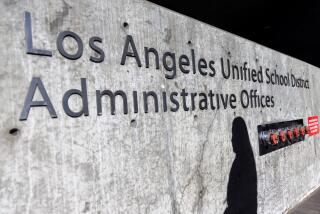ANAHEIM : Education Is Key in Anti-Drug Program
- Share via
Like other police officers, Chris Sayers is trying to prevent crimes. But any crime Sayers prevents would not have occurred today, tomorrow or next week. They would have occurred three, five or 10 years from now.
Sayers is one of five officers the Anaheim Police Department has assigned full time to its DARE program, which attempts to teach elementary school children how and why they should avoid gangs and drugs. A sixth officer will be added within the next few weeks. DARE, which stands for Drug Abuse Resistance Education, is taught throughout Orange County and the country.
“I know people are going to say, ‘We need more officers in the street and not the schools,’ ” said Sayers, an 11-year veteran of the department who has been teaching DARE for about one year. “I agree that interdiction is an important part of crime prevention. We need to catch the bad guys and lock them up. But we also need to educate our children. That’s the best way to keep them away from drugs and gangs.”
Sayers is assigned to five schools in west Anaheim, spending one day a week at each.
His day begins in the classroom, giving a fast-paced one-hour lecture about some aspect of drug abuse or gang membership. Topics include building self-esteem, decision making and resisting peer pressure.
Rather than using scare tactics or just ordering students not to use drugs or join gangs, Sayers said he simply tells the students about the dangers associated with drugs and gangs and then tells them that one day they will have to decide for themselves what type of life they will lead.
“As any parent knows, simply telling a child not to do something doesn’t always work,” Sayers said. “There are going to be times when the parents aren’t going to be there and the child is going to have to have the tools and the knowledge to say ‘No’ on his or her own.”
On one recent morning at Hansen School, Sayers, dressed in his uniform but without his gun belt, stood in front of a sixth-grade class and talked to them about gangs. There are about 50 gangs in Anaheim with a total membership of 900 and the average member between the ages of 11 and 17.
“I want to be fair, so can anybody name something positive about gangs?” Sayers asked the class. Gangs offer protection, someone suggested.
“Let’s look at that,” Sayers said. “Do they offer protection? And at what price?”
He tells the class that while gangs may say they offer protection, it is gang members who are the young people most likely to get shot or wind up in jail. And not only do gang members get shot, their family members are at risk from being struck by bullets fired at their home in drive-by attacks.
“Gang membership doesn’t only affect yourself, but it could wind up hurting your brothers, sisters and your parents,” Sayers said.
The students seem to respond eagerly to Sayers’ lesson. They offer their own stories about how gang members are damaging their neighborhoods. Those interviewed said the DARE program has given them information about drugs and gangs that will help them in junior and senior high school.
“I really didn’t know a lot about drugs, not even their names,” Tram Nguyen, 11, said. “I now know why I wouldn’t want anything to do with them.”
“I’ve learned that I shouldn’t be frightened to say ‘No,’ ” 11-year-old Queosha Eason said.
Teacher Penny Beck said she has noticed a difference in her children.
“The kids seem to enjoy Officer Sayers and they look forward to his visits,” she said. “He not only talks to them in class, but he stays for lunch and plays basketball with them on the playground. And the ones with behavior problems seem to be drawn to him the most. Many of them don’t have fathers at home and it’s important for them to get positive response from a father figure.”
But even the good kids say they benefit.
“I know that if somebody offers me drugs I should just make eye contact, say ‘No’ and then walk away,” Loc Duong, 12, said.
More to Read
Sign up for Essential California
The most important California stories and recommendations in your inbox every morning.
You may occasionally receive promotional content from the Los Angeles Times.










